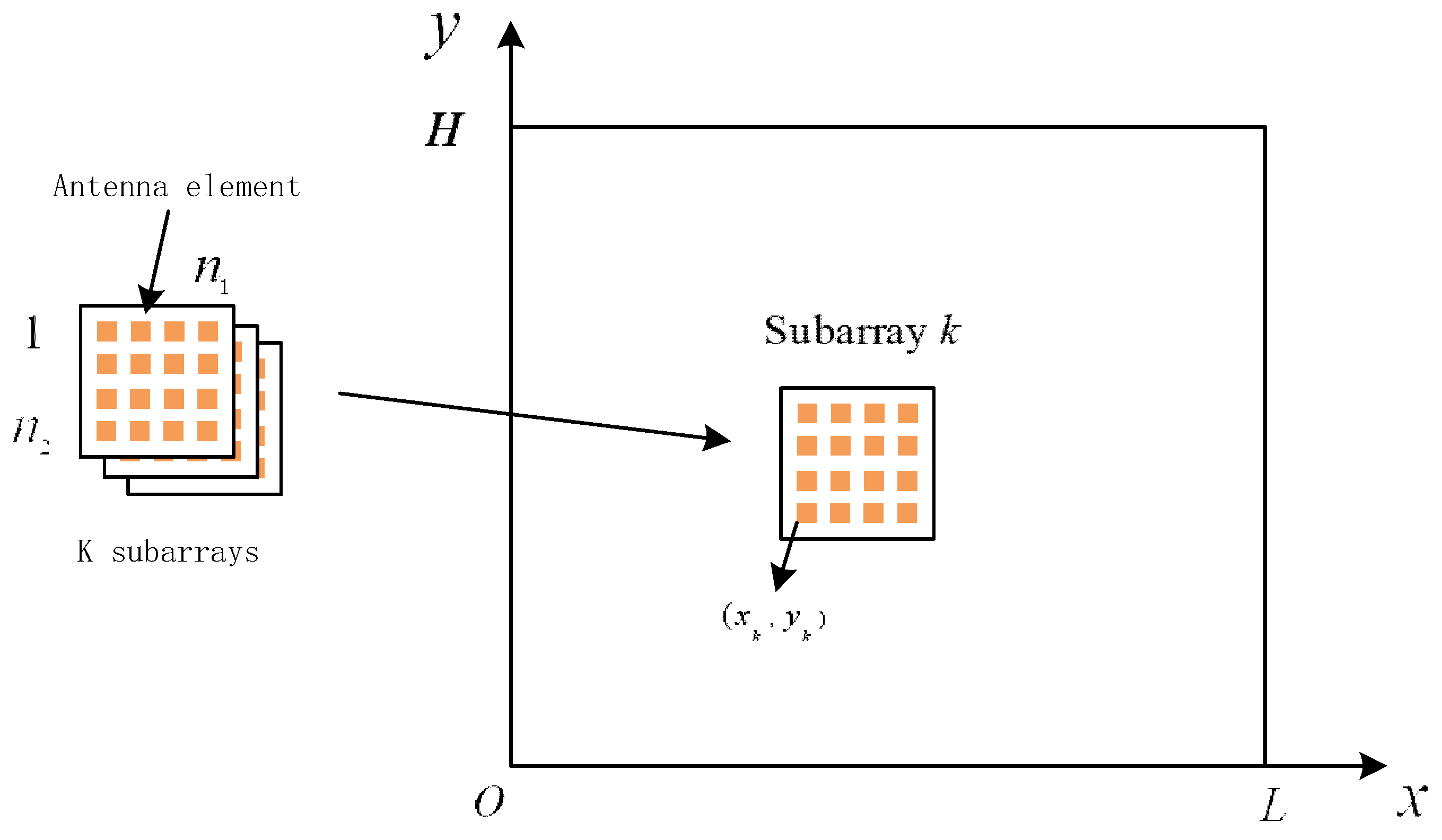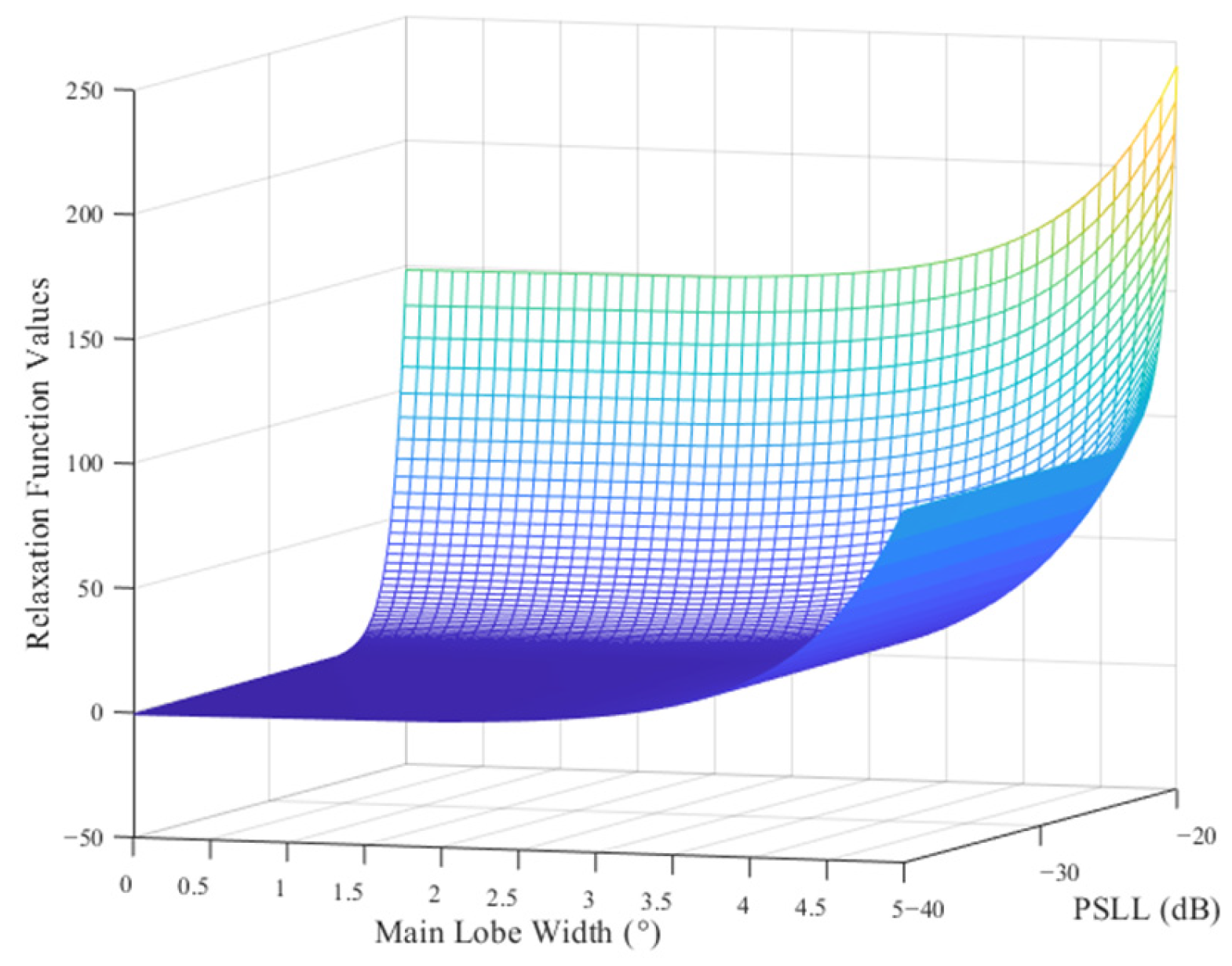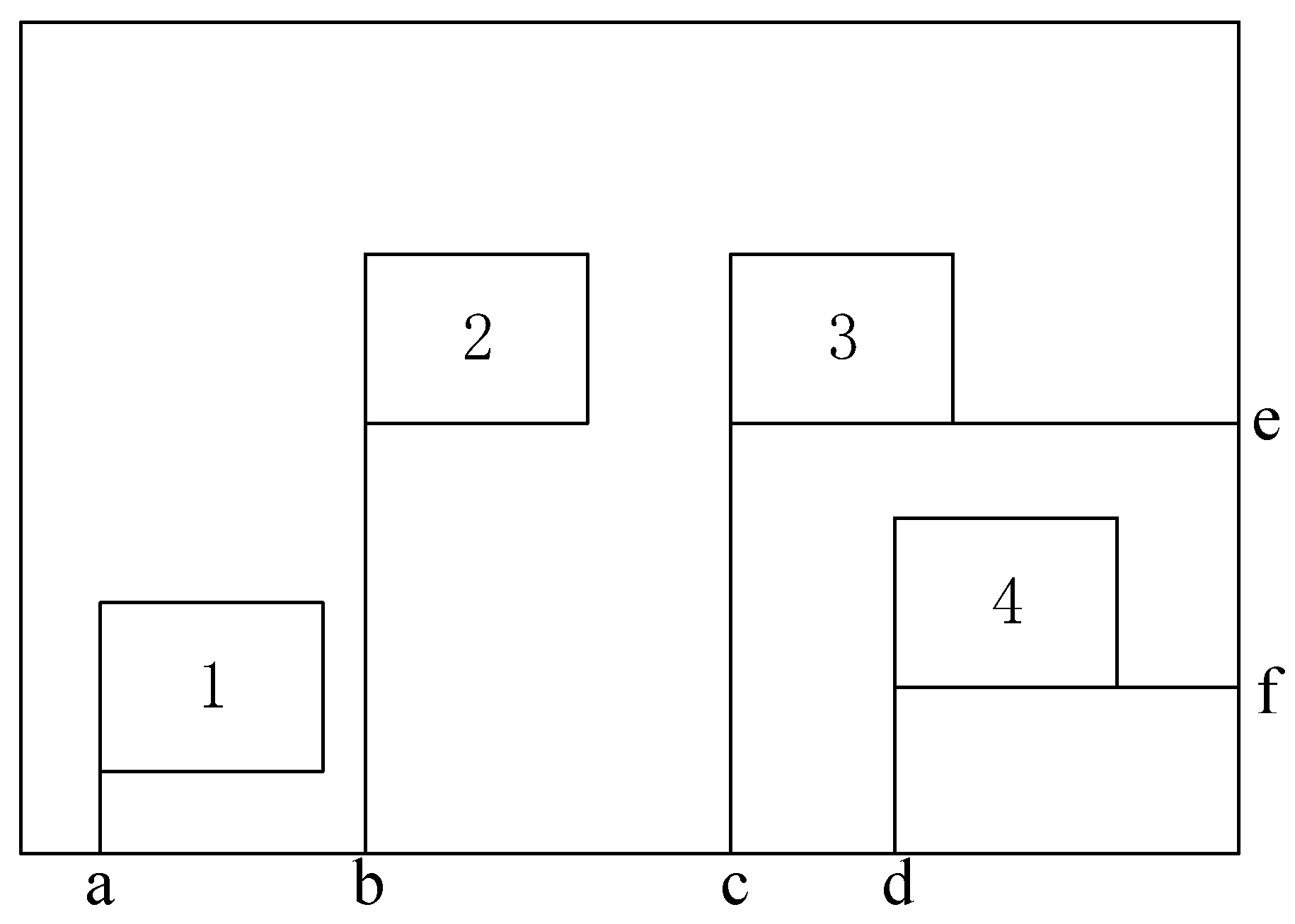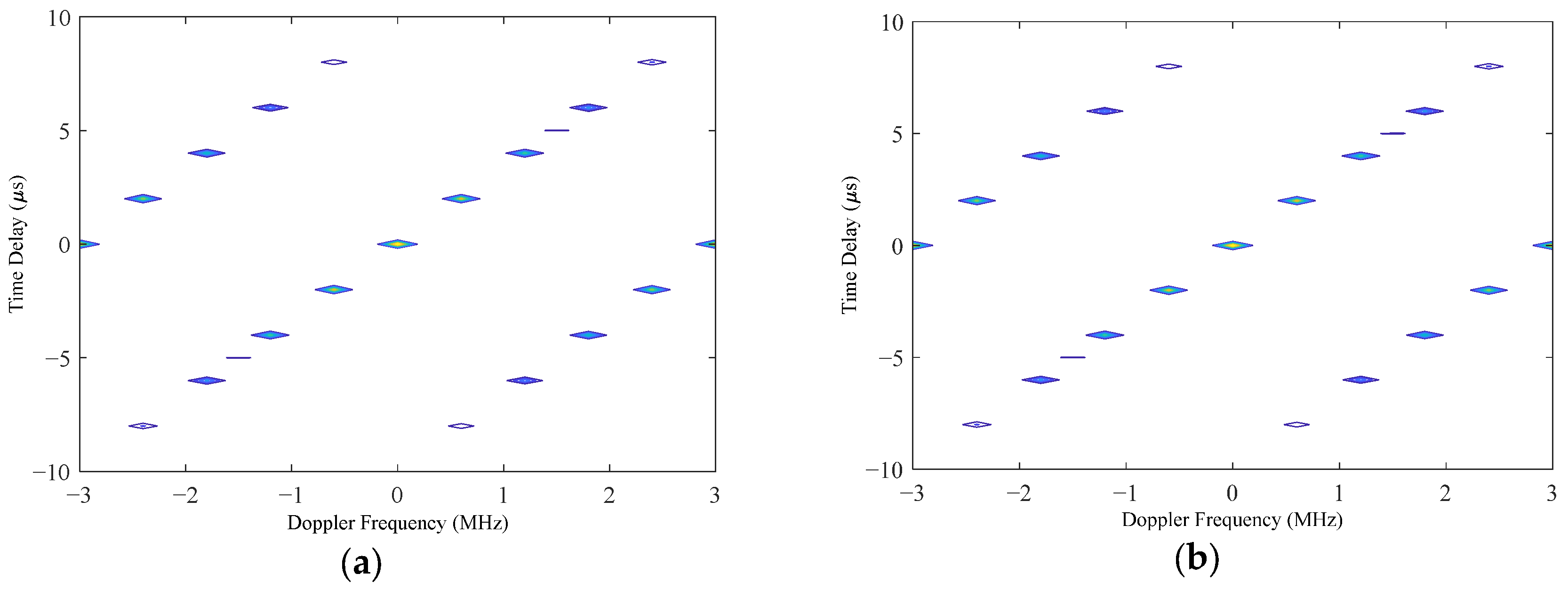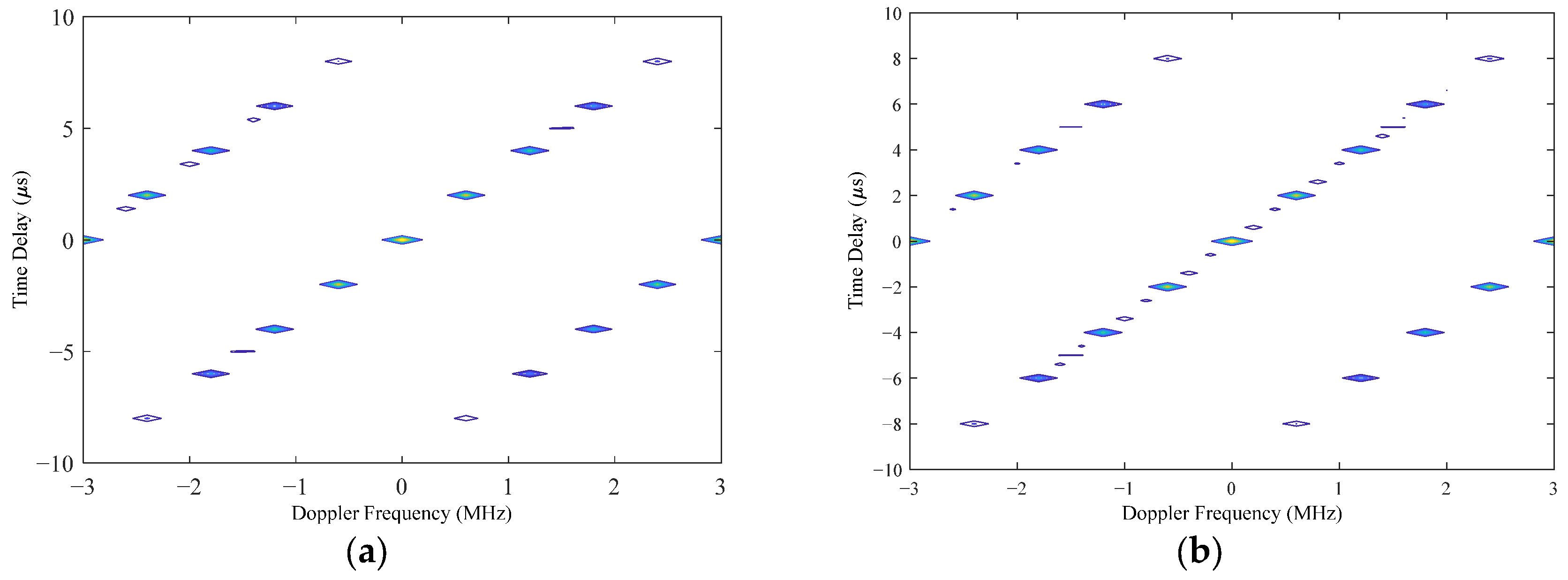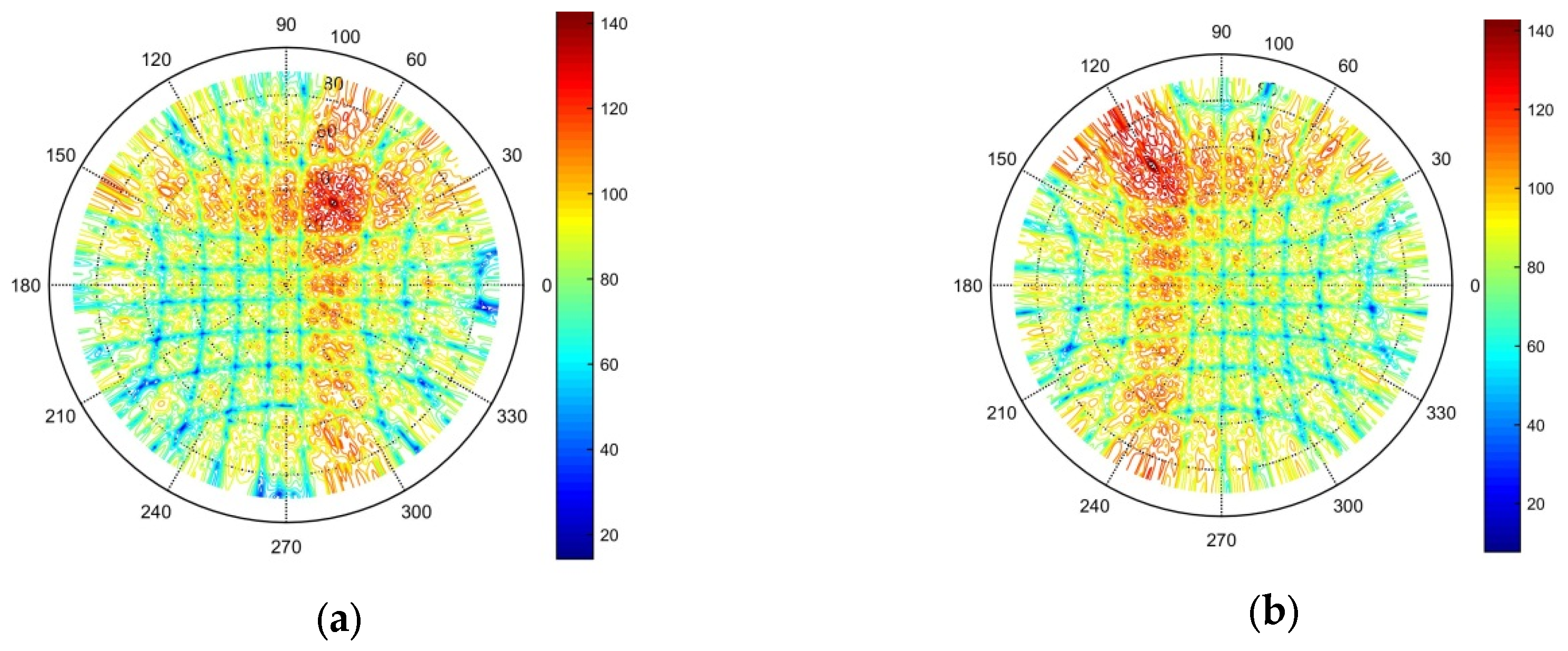1. Introduction
In modern radar systems, array antennas are increasing in size, as they contain hundreds or even thousands of antenna elements. As the array antenna becomes large, the digital channels required for each array element remarkably increase the hardware cost and system complexity. Especially in aircraft, ships, and other limited spaces, increasing the array antenna aperture by simply increasing the number of antenna elements is impossible. On the other hand, with the continuous development of antenna array microsystems, low profiles, high efficiency, and light weights are becoming increasingly important, and it is difficult to effectively reduce the hardware overhead of antenna arrays in micro-sized spaces. To overcome these problems, usually a number of array elements are grouped into subarrays to form subarray antennas. To further increase the antenna aperture and enhance the spatial resolution of targets while maintaining the scale, we need to increase the subarray spacing to sparsely arrange them. Therefore, the grouping of array elements into subarrays and arranging them are the primary issues to be solved when designing an antenna array.
Subarray grouping and arrangement are closely related to beam performance. Starting from monopulse angle measurement, Nickel [
1] explored methods to fabricate a sum-difference beam with low side lobes and suppressed interference under interference conditions. With regard to subarray designing, Xu et al. [
2] used the equivalent noise power method to design nonuniform adjacent subarrays for ULAs with amplitude tapering, low side lobes, and no grating lobes. Because it is impractical to precisely divide the antenna aperture using predefined subarrays, the authors of [
3] proposed the concept of relaxation units to develop a mathematical description based on the exact coverage theory, which can obtain a quasi-optimal subarray grouping scheme. Xiong et al. summarized signal processing for phased-array radars (PARs) based on subarrays, analyzed the optimization criterion for subarray grouping, and proposed the research direction for subarray grouping [
4]. Zhang et al. [
5] proposed a two-multibeam multiplexing design for arbitrary directions with varying and fixed antenna spacings based on the interleaved subarray architecture. In [
6], a non-iterative algorithm based on the amplitude density was applied to an initial solution of array sparseness, and the improved GA was used for further optimization, where array element symmetry constraints are proposed to enhance the optimization effect. In [
7], a differential evolutionary algorithm was used in the array design to reduce side lobes and the grating lobe level, and then a 2D-MIMO sparse array was designed to achieve high angular resolution in terms of both azimuth and elevation. In [
8], an effective approach for synthesizing sparse planar arrays using the three-step mapping method was proposed by decomposing the array optimization process into three steps: region partitioning, placement along the x direction, and placement along the y direction. Because optimization of the subarrays of array antennas is a nonlinear and nonconvex optimization problem, it was achieved by establishing an objective function and finding the optimal solution through the cyclic iterations of intelligent optimization algorithms, such as genetic algorithms [
9,
10], particle swarm algorithms [
11,
12], simulated annealing algorithms [
13,
14], and hybrid algorithms [
15,
16].
Li et al. proposed a novel array structure comprising irregular and overlapped subarrays [
17] which integrated the advantages of two types of subarrays to achieve performance requirements while reducing the cost. Furthermore, several studies have been conducted prior to developing this technology for real application. In one study [
18], fine-grid sparse antenna arrays were used to refine traditional half-wavelength grids to improve the freedom of the sparse optimization process and reduce the number of active elements. Furthermore, a new pruned fast Fourier transform was proposed to eliminate all redundant operations in beamforming, one which is suitable for fine-grid sparse antenna arrays. Additionally, a novel sparse antenna array comprising co-prime and nested subarrays was designed, and a corresponding two-dimensional (2D) direction of arrival estimation method was presented [
19]. Meanwhile, an irregular subarray-based low-cost sensor array design strategy was also proposed [
20]. Especially for large-sized cases, a hierarchical subarray design strategy was presented. A research group [
21] considered a shared aperture system where optimum sparse subarrays were allocated to individual SOIs and collectively spanned the entire full array receiver aperture. Each subarray might have its own antenna type and could be composed of different numbers of antennas. An optimum joint sparse subarray design for a shared aperture was proposed based on maximizing the sum of subarray beamformer SINRs, where there are threshold constraints with and without SINRs. Moreover, a multi-objective optimization framework was employed for the placement of subarrays within a prescribed area, which is dictated by form factor constraints [
22]. Hence, a tradeoff occurs between the small beam width obtained by spacing out the subarrays and the grating and side lobes created by the sparse placement. Therefore, based on 16-element (4 × 4) subarrays in the 60-GHz band, the effectiveness of the method has been verified via numerical examples.
With the development of multiple-input multiple-output (MIMO) technology, the subarray design is combined with MIMO radar in the hybrid-phased MIMO (HPMIMO) radar operation mode. HPMIMO adopts a phased-array mode inside the subarray and operates in the MIMO mode among subarrays. It contains the coherent processing gain of PAR and the MIMO waveform diversity gain of the radar. Hassanien et al. divided a transmitting array into a number of uniformly overlapping subarrays in 2010 to address the problem of subarray grouping for one-dimensional linear arrays. Furthermore, to design HPMIMO radar based on uniformly overlapping subarrays, they transmitted the signal to the target in the phased-array mode. Moreover, they transmitted mutually orthogonal signals between them in the MIMO radar mode [
23]. In 2013, one study [
24] proposed extending the HPMIMO radar operating mode to resolve the subarray grouping issue of 2D planar arrays. The main objective of the study was to divide the space into segments by generating beam patterns to be applied to the target tracking mode. For HPMIMO radar performance analysis, the modal function of HPMIMO radar was derived based on overlapping subarrays, and the mathematical properties of the ambiguity function were analyzed [
25]. A joint transmit subarray grouping and beamforming design method was proposed by J.S. Huang et al. [
26], where the transmit array was equally divided into a certain number of non-overlapping subarrays based on 2D HPMIMO radar. Subsequently, a joint optimization model was established for the subarray structure, transmitted beam power vector, and received beam power vector under the constraint of maximizing the output SINR. Finally, the model was solved in a circular, iterative manner. However, the method requires several iterations for algorithm optimization; therefore, it is less flexible and adaptable. In 2019, Tahcfulloh et al. divided the transmitting and receiving arrays into overlapping subarrays with the same number of array elements. Furthermore, they proposed an operating mode for FPMIMO radar [
27] using a phased-array approach for signal transmission and reception in subarrays. In this mode, the receiver and transmitter were co-located, and various waveform combinations were transmitted using multiple subarrays to effectively improve the coherence and waveform diversity gains, along with exhibiting system flexibility. However, research on FPMIMO radars in terms of the air spatial filtering algorithm is rather limited and lacks robust algorithm designs.
This paper mainly studies the sparse optimization problem based on two-dimensional subarrays. Under the given array aperture, number of subarrays, and size of the subarrays, while satisfying the antenna aperture, eliminating grating lobes, and ensuring no overlap of subarrays, the optimization objective is to minimize the PSLL and the main lobe width as much as possible. By establishing an optimization mathematical model, the positions of the subarrays are optimized and solved. For multiple optimization results, the optimal solution is selected using the radar ambiguity function. Finally, a two-dimensional subarray-level antenna sparse optimization design applicable to phased array MIMO radar is achieved. This can improve the radar’s spatial resolution while suppressing grating lobes and high side lobes and significantly reduce the size of the subarrays in the array antenna, the hardware cost for data acquisition and processing, and energy consumption. This is of great significance for the development and application of radar technology. For the sparse optimization problem of array antennas, it is a nonlinear and nonconvex optimization problem. Usually, intelligent optimization algorithms are adopted, and the optimal solution is achieved through iterative looping to find the best solution, such as a GA, PSO, simulated annealing, or the ant colony algorithm. This study focuses on the problem of the optimal arrangement of sparse antenna arrays and proposes a new optimal design based on the GA–PSO hybrid optimization algorithm and ambiguity function in the FPMIMO radar operation mode. The proposed algorithm can adaptively adjust the number of optimization iterations according to the optimization results during optimization of the PSO algorithm and GA. This strongly ensures the global optimization performance of the algorithm and determines the subarray’s sparse optimization scheme by combining the ambiguity function graphs of the subarray’s sparse optimization results. This manuscript contains the following sections.
Section 2 introduces the problem and algorithm model by first describing a sparse antenna array of 2D subarrays, then establishing an optimization model for array designing and a signal model for an array in FPMIMO mode, and finally deriving the ambiguity function of the array.
Section 3 describes the implementation steps of the algorithm comprehensively.
Section 4 presents a simulation test to verify the effectiveness of the algorithm. The conclusions of this study are given in
Section 5.
3. Algorithm Implementation Steps
Based on the above analysis, the basic idea of the algorithm introduced in this section is to calculate the main lobe width and PSLL for the subarray grouping scheme according to the transmit radiation pattern described in Equation (21), determine the fitness value described in Equation (4), and provide a basis for evaluating the array scheme. A position vector of a sparse antenna array of subarrays with optimal fitness can be obtained through the circular iterative optimization of the GA–PSO hybrid algorithm. The position vector is then combined with the ambiguity function of the FPMIMO radar based on a sparse antenna array of 2D subarrays obtained in Equation (40) to determine the optimal sparse antenna array scheme.
In the optimized sparse antenna array of 2D subarrays, an improved GA–PSO hybrid algorithm is proposed for optimizing the array design of 2D subarrays. This method integrates the global optimization capability of the GA algorithm and fast local optimization performance of the PSO algorithm such that the chromosomes in the GA algorithm correspond to particles in the PSO algorithm. According to the objective function of the problem, a fitness function is established based on the objective parameters. In the GA algorithm, the diversity of species is enhanced via cyclic evaluation, selection, crossover, and mutation operations on a species comprising several solutions to avoid local optimal solutions in order to obtain a group of individuals with the best fitness as the optimal solution for the problem as a whole. In the PSO algorithm, the chromosomes in the GA algorithm are given an initial velocity, and the local optimal solution is solved based on the optimal solution set using the fast optimization capability of the PSO algorithm. The hybrid algorithm combines the merits of the GA and PSO algorithms, reduces its dependence on the initial specifics, achieves adaptive convergence, and enhances the global optimization ability of the GA algorithm with the fast local optimization performance of the PSO algorithm.
The flowchart of the GA–PSO hybrid algorithm is shown in
Figure 4, and the specific steps of the algorithm are described as follows.
Step 1: An initial species containing several subarray position vectors is randomly generated based on the subarray spacing requirements, where each position vector is considered a chromosome in the GA algorithm or a particle in the PSO algorithm. Furthermore, each chromosome (particle) is given an initial velocity in the direction of the and axes.
Step2: The initial species are divided equally into subspecies and optimized separately using the PSO algorithm.
Step3: Update the velocity and position vector of each particle using the following equation:
where
is the inertia weight,
is the positive learning factor,
is a random number uniformly distributed between 0 and 1,
is the velocity vector of the particle after
iterations,
is the global optimal particle position vector, and
is the current optimal position vector of the
particle.
Step 4: Reasonability evaluation is the step which primarily determines whether the generated new subarray position vector
meets the constraints
and
, i.e., checking whether it is within the array range and whether the subarray elements overlap. First, the
coordinates of the subarrays are arrange from smallest to largest. Second, starting from the second subarray’s
coordinates, the spacings with all previous subarrays
are calculated, and the subarray combination whose subarray spacing in the
-axis direction is smaller than
is recorded. Finally, it is determined whether the subarray combination
in the
direction satisfies the constraint
; if not, then the newly generated subarray positions do not meet the constraint. Subsequently, we need to regenerate coordinates for new subarray positions. As shown in
Figure 5, suppose that there are four subarrays that need to be sparsely and optimally arranged, and only the spacing between subarray 3 and subarray 4 is in the
axis direction
. Then, the spacing between subarray 3 and subarray 4 in the
axis direction needs to be compared with that in the
x axis direction. Because
, this scheme meets the constraint that any two subarrays must not overlap.
Step 5: According to the equation of the fitness function (Equation (4)), the fitness value of each particle is calculated. Followed by storing them in the corresponding local optimal values , updating the local position optimal vector , and identifying the global optimal particle and its optimal fitness value via comparison.
Step 6: If a new global optimal fitness value is generated during the optimization process, then the counter for the number of consecutive non-updates is set to zero; otherwise, the counter is increased by one.
Step 7: If the number of consecutive non-updates exceeds the predefined threshold, then the PSO algorithm reaches a local optimal value. Then, the cycle is exited, and the optimal value is outputted. The criterion can be set to the extent that the local optimal value is not updated for consecutive times, and the local optimal condition is considered to be satisfied.
Step 8: When all subspecies are locally optimized by the PSO algorithm, all outputs can be synthesized into a new species.
Step 9: The new species is substituted into the GA and selection, crossover, and mutation operations are performed. The chromosome with the best fitness in each subspecies is directly selected, the remaining chromosomes are ranked from the smallest to the largest fitness values, and then the chromosome is selected for the next round using a roulette strategy. The crossover process is for exchanging a selected chromosome with another one in a randomly selected species for a randomly selected subarray position coordinates or . The mutation operation is a random change in the position coordinates or of a selected chromosome in a randomly selected subarray, resulting in a new chromosome.
Step 10: The reasonability evaluation in Step 4 is performed. The newly generated chromosome must meet the design requirements to proceed to the next step; otherwise, the previous step is repeated, and a new chromosome is regenerated.
Step 11: The fitness value of each chromosome within the species after crossover and mutation is calculated, and it is compared with the global optimal fitness values. If it is smaller than the current global optimal value, then the global optimal fitness value is updated and the counter is cleared; otherwise, the continuous non-update counter is increased by one.
Step 12: If the continuous non-update counter does not reach the maximum value , then the iterative optimization using a GA is continued; otherwise, the optimal 20% chromosome is outputted to the selected species.
Step 13: The PSO algorithm is used again to perform local optimization on the result outputted by the GA algorithm, and the global optimal result is outputted if the optimal value is not updated for consecutive times. Note that the constraints must be checked for each operation (position update, crossover, and mutation) of the PSO algorithm and GA.
Step 14: The optimization process of the hybrid GA–PSO algorithm can be performed several times to output a set of several sparse antenna array schemes with similar fitness values, and comprehensive performance analysis and evaluation can be performed by combining the ambiguity functions of an FPMIMO radar based on a sparse antenna array of 2D subarrays provided in Equation (40). By identifying the advantages and disadvantages of the target distance and Doppler resolution according to the ambiguity function graph, we can determine the optimal array design.
Through analysis, the computational complexity of the proposed algorithm is mainly derived from two aspects: the cyclic iterations of an intelligent algorithm and the calculations of the radiation pattern during every iteration. Therefore, the computational complexity of the proposed algorithm is O((M + 1)), where is the average iterations of PSO, is the average iterations of the GA, and and are the number of sampling points for the azimuth and pitching, respectively. Compared with other algorithms, the computational complexity is relatively high, but it has no impact on the practical applications. Because the proposed algorithm is only used for designing the sparse antenna array for 2D subarrays, which can be completed with a supercomputer in an offline fashion, the FPMIMO radar only uses the optimization result of the proposed algorithm. Therefore, it is worthwhile to obtain a high-performance sparse array antenna by running this complex algorithm.
4. Simulation Results and Analysis
To verify the effectiveness of the proposed algorithm based on the GA–PSO algorithm and the ambiguity function for a sparse antenna array of 2D subarrays, in this section, we apply the algorithm to iteratively solve a sparse antenna array of subarrays. For the simulation experiment, the main simulation parameters are shown in
Table 1, assuming that the radar signal frequency was
. Additionally, we needed to optimize an array of
subarrays, each of which was a 2D uniform array of
, with the internal elements being spaced at an interval of half the wavelength, and equipped with a sampling channel. The array was on a 2D plane which had a size of
. In the optimization process, the uniform phase and magnitude distribution were used to obtain beamforming coefficients for each subarray. Moreover, the steering vector of each subarray was used as the weight vector.
During the simulation, simulation beam pointing was set to the direction, and the subarray positioning accuracy was 0.1 mm. Each subarray was calibrated with the position of its reference array element, which is the element in the first row and first column of the subarray. With regard to the optimization objectives, the expected value of the PSLL was set to ; the upper limit of the error for the peak sidelobe was set to ; the expected value of the main lobe width for the transmit radiation pattern was set to ; the upper limit of the error for the main lobe width was set to ; the upper limit for the number of consecutive non-updates of the optimal fitness for the PSO algorithm and GA were set to and , respectively; and the other parameters of the fitness function in the iterative operation were set to , , , and . The initial species size and number of loop iterations for the GA and PSO algorithm in the test were set to 100, and the species were divided equally into five subspecies. In the GA, the selection probability was set to 0.2; the crossover probability was set to 0.85; and the variance probability was set to 0.15. In the PSO algorithm, the inertia weight was set to ; the positive learning factors were and ; the angular resolution of the simulation experimental process was ; and the maximum motion distance of constrained particles in the and directions for each iteration process was 10d. In addition, the fitness functions of PSO and the GA were the same for the proposed approach in Equation (4), and the comparison result could prove the optimization performance of the proposed algorithm.
Through the simulation experiments of two optimized arrays, the adaptation value change process for the first array optimization design cycle iteration process is shown in
Figure 6. The proposed method achieved the best optimized array, with a PSLL of −15.14 dB, a main lobe width of
, and an adaptation value of 1.0477. The optimized array is shown in
Figure 7a, and the coordinates of its subarrays were
and
The PSLL for the second array optimization design was −15.36 dB, the main lobe width was
, and the fitness value was 1.0182. The optimized array is shown in
Figure 7b, and the coordinates of its subarrays were
and
According to the results of the two experiments, we can see that the main lobe width was
and the PSLL was below −15 dB; therefore, both optimization results met the predefined optimization objectives. To select an optimal array scheme from them, we could further analyze them by creating an ambiguity function graph.
Figure 8a,b illustrates the contour plots of the ambiguity function for the first and second optimization results, respectively. According to these graphs, if there was no pointing error in the MF-processed transceiver beam, i.e., the transceiver beam and target location of each subarray were in the
direction, then the ambiguity function graphs of the two optimization schemes are almost the same. Meanwhile, when the MF-processed beam had a pointing error of
in the azimuth and elevation angles, i.e., the target space angle was
while the MF-processed radar transceiver beam pointed in the
direction, then the contour plot of the ambiguity function is shown in
Figure 9.
Figure 9a shows that there was no significant change in the ambiguity function curve for the first optimized array, while the curve for the second optimized array shown in
Figure 9b exhibits more spikes. This shows that the ambiguity function of the second optimized array was more affected by the pointing error of the MF-processed transceiver beam. Based on the results of the ambiguity function graph analysis, the first optimization result was selected as the final solution for the sparse antenna array, and the transmit beam pattern is shown in
Figure 10. There was no grating lobe in the beam pattern, and the sidelobe gain was kept at a relatively low level, indicating that the optimization result achieved the predefined objectives.
To fully verify the effectiveness of the optimization results for the sparse antenna array of 2D subarrays, the validity of the array antenna’s transmit radiation pattern was tested, and the transmit beam gain was kept within the range of 0–150 dB to facilitate presentation of the results in polar coordinates. The simulation results are shown in
Figure 11.
Figure 11a shows the transmit radiation pattern when the transmit beam was pointing at an azimuth angle of
and elevation angle of
;
Figure 11b demonstrates the pattern when the transmit beam was pointing at an azimuth angle of
and elevation angle of
;
Figure 11c depicts the pattern when the transmitting beam was pointing at an azimuth angle of
and elevation angle of
; and
Figure 11d displays the pattern when the transmitting beam was pointing at an azimuth angle of
and elevation angle of
. The simulation results show that by randomly pointing the transmit beam, the transmit radiation pattern only exhibited a peak in the beam pointing angle, and the grating lobe was not observed. Moreover, the side lobe gain was effectively suppressed, which fully proves the effectiveness of the optimized sparse antenna array of subarrays.
